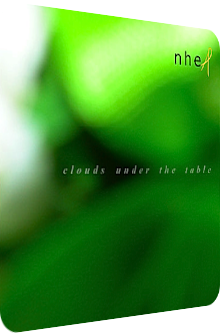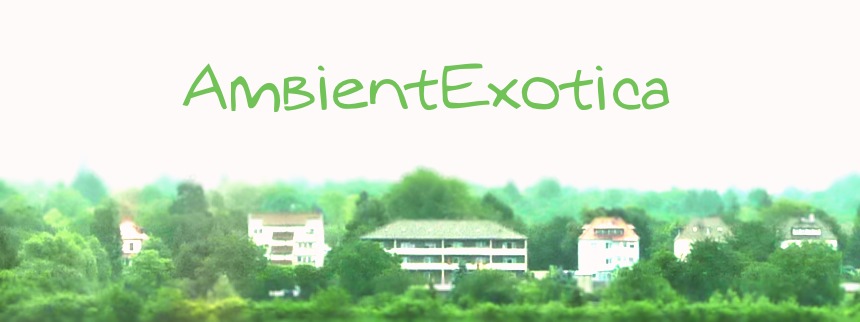
Nheap
Clouds Under The Table
2011
Nheap is the moniker of the Italian composer and drummer Massimo Discepoli who picks up the particular characteristic traits and peculiar attributes of varied genres such as Jazz, Rock and Ambient in order to let their intertwining unfold. The aesthetics of Rock are usually the least noticeable ingredients, as his sound is more focused on electronic devices such as the electric piano and his classic drum kit. Clouds Under The Table is his third album, was two years in the making, released in October 2011 on the Acustronica label, and due to its wide array of styles and traditions, it is hailed by many different people and reviewers with many different backgrounds for its well-balanced fusion. Naturally and unsurprisingly, it is the Ambient parts which attract my interest the most, and luckily enough is the genre's impetus perceptible throughout the release. The mood mostly orbits around a slightly melancholic and icy, but also uplifting and forward-moving aura all the time. This is not the only contradiction Discepoli successfully turns into a synergetic force. Eight compositions are presented, and since they are chock-full of many styles and genres, the question remains whether the artist can offer a coherent listening experience or whether this is a cut-and-paste gallimaufry full of differences. It turns out that in the hands of this talented musician, everything fits together in order to build an endemic mood that is itself open to scrutiny and interchangeability. This is no terrifying Avantgarde release. Massimo Discepoli tries to make his music as accessible and eclectic as possible, thus circumnavigating the snobby notions that are still linked to the world of Jazz. I do not agree with every single one of his choices, but am drawn into this release anyhow. You can listen to Clounds Under The Table in full via this Bandcamp link. Access to a digital version of this album was given to me by the artist himself for review purposes.
Gradients opens the album as a glaring example of the synergetic esprit that meanders through the whole work. A spiraling vibraphone-accentuated piano arrangement is unleashed, and despite its jumpiness and crunchy clarity, it feels aqueous and goodnatured, distantly resembling an African spirit in the veins of Tony Scott’s famous marimba interludes off African Bird: Come Back Mother Africa (1984). Although Massimo Discepoli’s intrinsic soundscape differs in texture, it invokes a similar timbre. An additional wraithlike synth ethereality floats in the distance, allowing Gradients the big shift from the former eupeptic contemplation to a seraphic superimposition. This enchanted encapsulation is creatively perturbed by another electronic-related aspect, namely a sudden juxtaposition of the prologue which literally throws the listener off the track for a moment, especially so at higher volumes, as the extremely immediate loss of the synth stream causes a sudden emptiness. The Italian composer builds it anew, adds a terrifically spellbinding synthetic haze as a backdrop… and deconstructs this blissful state once more with one final violin-interspersed version of the piano loop whose pitched-down fadeout marks the end. The dynamic changes and morphological features remind of Pascal Schumacher’s and Jef Neve’s Face To Face (2010) which is based on similarly catchy, seemingly easygoing but increasingly growing and convoluted melodies. The roughly five minutes of this opener are undoubtedly based on the best concept and outshine every other track in this regard. This does not mean there are no more surprises in store! A conceptually good opener sets the feeling of an album straight, and Gradients does it very successfully, its leitmotif is tremendously catchy, regardless of the current state in which it resides any given moment.
The following 5 March turns things down a notch or two only to mask the fact that it is actually an even more dynamic composition than the opener. Digital chimes, bells and twinkles start to get entangled and form a multifaceted crystal antrum awash with a pastel-colored luminescence. Golden sun-soaked synth washes meet and depart with the blurry mist, a mild drone-underpinned Jungle rhythm is injected and flows along next to the mellow melodies. The achievement of Nheap cannot be overstated here, as this Detroit-like track almost crosses the path to the haphazard Lounge realms. The beat might back this assertion, but not so the eclectic interdependence of the bright bells and whitewashed whistles which form an ambiguously easygoing effervescence. It is the most electronic track of the whole album. Again, the rhythmic structure is questionable due to the long tradition of lackluster Lounge music; the cloudy tone sequences and acroamatic surfaces, luckily, are a boon. Up next is The Snow That Never Falls Down, and this is the first track so far which shows Discepoli’s skills as a drummer, but first things first, since the introductory phase is pristine Ambient: a deliciously gelid purity unfolds in the form of oscillating legato creeks, frosty snowflakes, glistening electric pianos and glacial synth choirs. Heck, if the song went on like this, I would have been perfectly happy. A fusionist artist, however, has to advect certain slivers of Avantgarde to keep the surprise level intact, hence Nheap’s decision to spice it up with a laid back beat on the classic drum kit whose impetus grows as the song progresses. To my mind, the clashing cymbals do not work overly well in the otherwise fragile and highly mollifying clime, for they permeate the other layers too forcefully and piercingly. Then again does their whiteness link back to the hibernal landscape, so from a conceptual viewpoint, the Italian drummer succeeds as well, I just would have wished for a gentler, silkier beat that conflates with the languorous landscape.
Daily Improvisation delivers exactly what its title promises, a very intimate ambience with double bass bursts, drum-related practice sessions, electric piano scintillae, Space-Age buzzes and, to my great surprise, a welcome lucency of the background which adds verve and plasticity. The softly swooshing noises remind of passing cars, but could literally be everything else or anything at all. This tune allows a glimpse into the studio where the genius is at work. It is non-essential for the grandeur of the album, but a nice gesture for sure. Meanwhile, the title track Clouds Under The Table is an ever-changing progressive critter and turns out to be the morphogenesis of the album, as it contains and comprises of every endemic element which is so essential for the overall feel of Discepoli's third album. What launches with dry surf guitar twangs and spectrally flowing bells changes into a melancholic electric guitarscape in tandem with another Jungle beat plus deep bass drones and culminates into a crescendo of mercurial layers: cymbals, guitars, arpeggiated electronic rivers, swirling vesicles, everything is unchained at the same time and is featured in similar ways on every other track.
Sands is another luxuriously layered composition, but despite its title harks back to the icier material and an even stronger feeling of nostalgia. A rising five-note theme on the electric piano marks the beginning of a light blue-tinged diorama with whirring synth streams, a tranquilizing downbeat – with the volume level of the cymbals being wonderfully soothing most of the time – and a wondrous euphony when the beat stops. The rising level of tension near the end results in a gorgeous but short-lived Ambient vignette. As usual, I would have loved to feast on these intertwined layers a bit longer. The following Crossings thankfully offers this Ambient structure I so desire in an overexposed form right from the beginning. After this dichotomous introduction of warm synth bubbles and plinking electric pianos, a deep drone marks the launch of a classic drum beat, muffled public service announcements and a repeated electric piano cascade in the background which glimmers through the lacunar high-energy drum structure. It is the outro Rides that harks back to the sumptuous fields of snowy tonalities and introspective cogitations, but surprises with a fizzling, almost exotic beat and short Oriental tone sequences which are only perceptible when the electric pianos are muted. Whereas most of the other tracks provided an observant stationary viewpoint, Rides moves forward and superbly enough retains both the snugness and gentleness of the other arrangements, meshing a distinct Lounge feeling with an eminently electrifying beat pattern and a joyful backing synth-related monotony near the end that glows in a transfiguring, deeply embracing way. A terrific closer!
The hallmark of creativity on Clouds Under The Table can be found in the opener Gradients and its delicate stop-and-go notion – or motion? – of pasted alternated loops and gorgeous synth washes. To me, this particular track accomplishes the volition of merging immensely scattered and varied genres into a cohesive cocktail best. It is here where the resplendent aforementioned interaction of the synergetic kind can unfold when jazzy loops meet with electronic devices, are torn apart and then reassembled with the help of software. Sure enough does the cliché of the dedicated unwired Jazz musician not have the slightest chance in today’s world anymore. This form of artistic expression has been done before, sure, but whenever anyone's idea is revisited, it not only gets potentially better, but demands much more of the musician. Massimo Discepoli is a drummer and composer, but even more so an honest-to-goodness curator and has to make decisions that fall out of the reach of classical Jazz musicians. He carefully chooses his best loops and pastes them in a meaningful, oftentimes even purposely counterintuitive way in order to stress the dichotomy between Jazz and electronic music, piano arrangements and Ambient, instrument-related surfaces and artificial agents. Again, this idea is carved out most definitely in the opener, but the remaining material comes up with a flow that is not injected in the opener due to its very nature, but can twist and wind all the better in the following tracks, be it the glacial The Snow That Never Falls Down, the equally icy Sands or the superb mild-mannered Oriental tension and impression of steady movement in Rides; the color palette of Nheap resides in greenish and blue-tinged realms, as its artwork suggests, never branching off too far. Quite astonishing for such a synergetic album. My only two sources of criticism have to do with the all too piercing cymbals and with the at times infinitesimal ambience which I would have loved to be more in the focus. But since this critique is coming from an Ambient Reviewer, I can imagine how Rock fans or Jungle afficionados must feel, as these listeners are targeted as well, but have different needs and preferences. You cannot please everyone, especially not with a wildly varied album, which Clouds Under The Table is not! It is instead wonderfully consistent and cohesive, yet accessible and inventive. As I have previously implied: synergetic fusions are loaded with ambiguity and contrasts. Find out for yourself. Fans of glacial Ambient and mellow, easy-to-digest beat structures ought to be very pleased.
Ambient Review 171: Nheap – Clouds Under The Table (2011). Originally published on Jan. 16, 2012 at AmbientExotica.com.
